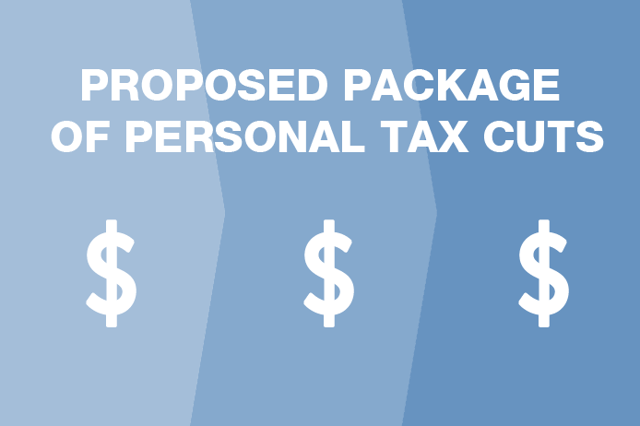By Professor
Robert Deutsch
Robert Deutsch
 |
| Click through to infographic above: Coalition's proposed package of personal tax cuts |
Q: Will the Coalition likely be able
to get its proposed package of personal tax cuts approved by Parliament?
to get its proposed package of personal tax cuts approved by Parliament?
A: The
answer to this question will very much depend on the composition of the Parliament
– in particular, the new Senate and the ability of the Government to negotiate
with the unaligned parties and independents.
answer to this question will very much depend on the composition of the Parliament
– in particular, the new Senate and the ability of the Government to negotiate
with the unaligned parties and independents.
There are actually three stages of personal tax changes
that are proposed by the newly elected Government.
that are proposed by the newly elected Government.
Stage 1
Stage 1 commences on 1 July 2019 and will include a
minor adjustment to the marginal tax rates and the introduction of a new $
1,080 low and middle income tax offset to apply with effect from 1 July 2018.
minor adjustment to the marginal tax rates and the introduction of a new $
1,080 low and middle income tax offset to apply with effect from 1 July 2018.
Ideally, Stage 1 would be passed by Parliament
before 1 July 2019; if after that date, more complex administrative
arrangements may be required. The way the quirky Australian electoral system
works is that the Senate as it stood before the 18 May election will continue
until 30 June 2019. This means that the Government will be working on the basis
of holding 31 Senate seats out of 76. While that leaves the Government well
short of the required majority of 39, this stage is supported by the Labor
party, which holds 26 seats and the Greens, which holds 9.
before 1 July 2019; if after that date, more complex administrative
arrangements may be required. The way the quirky Australian electoral system
works is that the Senate as it stood before the 18 May election will continue
until 30 June 2019. This means that the Government will be working on the basis
of holding 31 Senate seats out of 76. While that leaves the Government well
short of the required majority of 39, this stage is supported by the Labor
party, which holds 26 seats and the Greens, which holds 9.
Accordingly, Stage 1 will pass, although whether
that will happen before or after 1 July 2019 is not clear at this stage.
that will happen before or after 1 July 2019 is not clear at this stage.
Stage 2
Stage 2 which is scheduled to commence from 1 July
2022, sees more changes to the marginal tax rates which are more meaningful
than those which are to be adopted in Stage 1.
2022, sees more changes to the marginal tax rates which are more meaningful
than those which are to be adopted in Stage 1.
Stage 3
Stage 3, which is scheduled to commence 1 July 2024,
is more controversial with far more aggressive changes to the marginal tax
rates including a streamlined marginal tax rate such that there will only be
four marginal tax rates namely zero, 19%, 30% and 45%, with the 30% marginal rate
applying controversially to all income from $ 45,000 up to $ 200,000.
is more controversial with far more aggressive changes to the marginal tax
rates including a streamlined marginal tax rate such that there will only be
four marginal tax rates namely zero, 19%, 30% and 45%, with the 30% marginal rate
applying controversially to all income from $ 45,000 up to $ 200,000.
Stages 2 and 3 will be more difficult since both Labor
and the Greens have already indicated that they will oppose both stages. These
stages will need to pass through the new Senate, which commences from 1 July
2019. That Senate will most likely have the Coalition on 34 (possibly 35)
seats, Labor on 27 and the Greens on 9.
and the Greens have already indicated that they will oppose both stages. These
stages will need to pass through the new Senate, which commences from 1 July
2019. That Senate will most likely have the Coalition on 34 (possibly 35)
seats, Labor on 27 and the Greens on 9.
Labor and the Greens will oppose the measures,
which means that the Coalition will need the support of 5 of the 6 other senators.
This is where the Government’s negotiating power will be critical. The Government
and in particular the Prime Minister himself have gained considerable authority
as a result of the stunning election victory but whether that will be enough to
carry 5 of the 6 minor party/independents is difficult to assess. I would rate
their chances of passing Stage 2 at slightly better than 50-50 and the chances
of passing Stage 3 as slightly less than 50-50.
which means that the Coalition will need the support of 5 of the 6 other senators.
This is where the Government’s negotiating power will be critical. The Government
and in particular the Prime Minister himself have gained considerable authority
as a result of the stunning election victory but whether that will be enough to
carry 5 of the 6 minor party/independents is difficult to assess. I would rate
their chances of passing Stage 2 at slightly better than 50-50 and the chances
of passing Stage 3 as slightly less than 50-50.
Q: The Coalition had previously tried to sharply reduce taxes for all
corporations but was unable to drum up enough support in the Senate. Do the
election results suggest that plans for corporate tax cuts might be revived?
corporations but was unable to drum up enough support in the Senate. Do the
election results suggest that plans for corporate tax cuts might be revived?
A: The
position in Australia relating to corporate tax rates is now very confusing
with some companies paying tax at 30%, some at 27.5% and at various stages, some
as low as 25%. This is a most unsatisfactory arrangement and, in my view, it
would be preferable if the rate was a flat 25% for all companies.
position in Australia relating to corporate tax rates is now very confusing
with some companies paying tax at 30%, some at 27.5% and at various stages, some
as low as 25%. This is a most unsatisfactory arrangement and, in my view, it
would be preferable if the rate was a flat 25% for all companies.
The Government will certainly feel emboldened by
its success and may well seek to revive the possibility of a flat rate of 25%
for all companies. Again the Senate will become critical and again Labor and
the Greens who will likely control 36 of the 76 seats in the Senate will almost
certainly oppose this measure if the Coalition seeks to revive it. The likelihood
of the Coalition securing 5 out of the 6 minor party/independents on this issue
would in my estimation be low. Consequently, I do not believe that they will
revive this possibility.
its success and may well seek to revive the possibility of a flat rate of 25%
for all companies. Again the Senate will become critical and again Labor and
the Greens who will likely control 36 of the 76 seats in the Senate will almost
certainly oppose this measure if the Coalition seeks to revive it. The likelihood
of the Coalition securing 5 out of the 6 minor party/independents on this issue
would in my estimation be low. Consequently, I do not believe that they will
revive this possibility.
Q: Labor campaigned hard on the issues of curtailing what it described
as tax loopholes for franking credits and negative gearing. Did that strategy
backfire?
as tax loopholes for franking credits and negative gearing. Did that strategy
backfire?
A: With
the mess that election night presented for the Labor party, it is difficult to
be specific on what was the main cause of their poor performance.
the mess that election night presented for the Labor party, it is difficult to
be specific on what was the main cause of their poor performance.
However, it is clear that in a number of key seats
where Labor lost ground unexpectedly, there was a very high number of taxpayers
who would be effected by both these measures. In the campaign, the Prime
Minister, in particular, highlighted Labor’s franking credit policy time and
time again. The name given to it by the Government namely the “Labor party’s retiree
tax” did seem to create a very visible and vocal negative atmosphere around the
Labor campaign. In my estimation, these two measures had an impact on Labor’s
vote in at last a dozen key seats which Labor absolutely needed to win. There
is, in my view, little doubt that the strategy backfired very badly for Labor.
where Labor lost ground unexpectedly, there was a very high number of taxpayers
who would be effected by both these measures. In the campaign, the Prime
Minister, in particular, highlighted Labor’s franking credit policy time and
time again. The name given to it by the Government namely the “Labor party’s retiree
tax” did seem to create a very visible and vocal negative atmosphere around the
Labor campaign. In my estimation, these two measures had an impact on Labor’s
vote in at last a dozen key seats which Labor absolutely needed to win. There
is, in my view, little doubt that the strategy backfired very badly for Labor.
Q: Do you
have any other thoughts?
have any other thoughts?
A: At
one stage there had been a political strategy that ran along the lines: “Never
ever go to an election with a platform including more taxation”.
one stage there had been a political strategy that ran along the lines: “Never
ever go to an election with a platform including more taxation”.
It seems that the message had been largely
forgotten by Labor in preparation for this election. I do not believe that we
will ever see a campaign again in Australia where a party advocates for any
significant new taxation measures.
forgotten by Labor in preparation for this election. I do not believe that we
will ever see a campaign again in Australia where a party advocates for any
significant new taxation measures.
The stunning unexpected Coalition victory was
certainly in part driven by the attack which was launched against Labor’s
platform of tax proposals. Clearly there were other issues in play – climate
change, superannuation, childcare worker benefits – nonetheless Labor’s policy
on tax was clearly a gift to the Coalition which they exploited to great
effect.
certainly in part driven by the attack which was launched against Labor’s
platform of tax proposals. Clearly there were other issues in play – climate
change, superannuation, childcare worker benefits – nonetheless Labor’s policy
on tax was clearly a gift to the Coalition which they exploited to great
effect.










